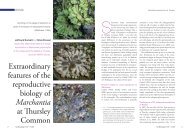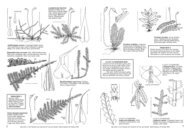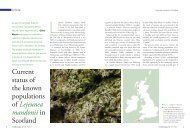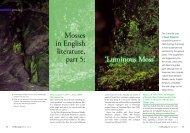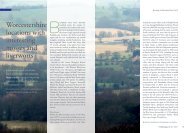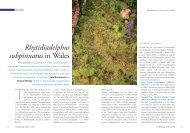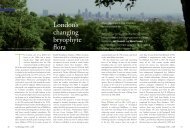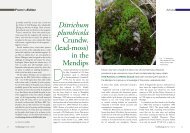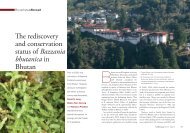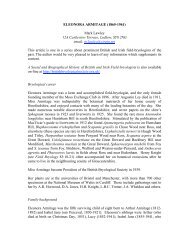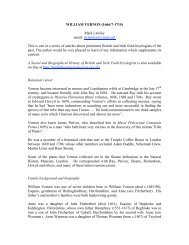JAMES NEEDHAM (1849-1913) Mark Lawley email: m.lawley ...
JAMES NEEDHAM (1849-1913) Mark Lawley email: m.lawley ...
JAMES NEEDHAM (1849-1913) Mark Lawley email: m.lawley ...
You also want an ePaper? Increase the reach of your titles
YUMPU automatically turns print PDFs into web optimized ePapers that Google loves.
<strong>JAMES</strong> <strong>NEEDHAM</strong> (<strong>1849</strong>-<strong>1913</strong>)<br />
<strong>Mark</strong> <strong>Lawley</strong><br />
<strong>email</strong>: m.<strong>lawley</strong>@virgin.net<br />
This is one in a series of articles about prominent British and Irish field-bryologists of the<br />
past. The author would be very pleased to learn of any information which supplements its<br />
content.<br />
A Social and Biographical History of British and Irish Field-bryologists is also available<br />
on-line at http://britishbryologicalsociety.org.uk/<br />
Botanical career<br />
Needham took up botany in 1885, in his mid-thirties, following a ramble to Hardcastle<br />
Crags with the Hebden Bridge Cooperative Society. In 1889 he met Charles Crossland<br />
(1844-1916), a master-butcher of Bull Green, Halifax, who introduced him to mosses and<br />
fungi, and the two men often accompanied each other on excursions. Needham became<br />
an accomplished mycologist, and contributed many records to W.B. Crump and C.<br />
Crossland’s Flora of the Parish of Halifax (1904). Needham also discovered the<br />
liverwort Jubula hutchinsiae in Hebden Valley near Hardcastle Crags in 1896.<br />
He often assisted other naturalists, one of whom was so grateful that he gave Needham a<br />
microscope “as a memento of a pleasant day spent … under your leadership…” Tom<br />
Blockeel recounts (see Bibliography, below) that Needham gained admiration and respect<br />
in local circles for his botanical expertise…. Needham’s “house was a store of botanical<br />
specimens, the walls being closely hung round with framed, mounted mosses…. On the<br />
other hand, Needham often had to tolerate a lot of leg-pulling from his workmates and the<br />
local farmers whose land he searched”, with one farmer describing his eccentric conduct<br />
in searching one pasture for the fungus Clavaria as “babby wark”. William Nowell<br />
wrote that “James Needham made a notable contribution to our knowledge of the flora of<br />
the district, including mosses and fungi, to such extremes that a farmer once described<br />
him as ‘“looking for summat as he we’nt know he’s fun till he gets it whom and puts it<br />
under t’ microscope.”’<br />
His herbarium is at the Bankside Museum in Halifax, with 95 additional plants at Bolton<br />
Museum. Leeds Museum Resource Centre has many of Needham’s letters and<br />
manuscripts, including the record book for bryophytes and fungi of the natural history<br />
section of the Hebden Bridge Literary and Scientific Society, for which Needham was<br />
recorder between 1907 and 1911 (catalogue ref: LEEDM.C.1990.1). Hebden Bridge<br />
Local History Society also has memorabilia relating to Needham.
James Needham: from the archive at Hebden Bridge Local History Society
Family background and biography<br />
James Needham was born at Hebden Bridge, Yorkshire on March 19 th <strong>1849</strong>, the eldest<br />
child of ten born to Thomas Needham (1829-1885), an iron moulder, and Mary (née<br />
Greenwood, 1830/1). Thomas was a son of John Needham (born c. 1801-6), also a<br />
moulder, and Betty (née Crabtree, c.1805/6).<br />
Families working in the textile industries of northern England in the early and middle 19 th<br />
century were themselves close-knit, and at the time of the 1851 Census Return, Thomas<br />
and Mary Needham lived next door to John Needham who had three younger members of<br />
the Crabtree clan with him.<br />
James’s siblings were Hannah (born 1850), Martha (1854), Betty (1856), Mary Elizabeth<br />
(1859-1890), Charlotte Ann (1861-1899), Alice Eliza (1864), Prisca E. (1866), Rachel<br />
(1868) and John (1870). In 1861 James was a doffer in a cotton mill, as was his sister<br />
Hannah. In 1871 he was an iron moulder (like his father); Hannah and Martha were<br />
cotton threstle-spinners, Betty was an apprentice dressmaker, and Mary Elizabeth and<br />
Charlotte Ann were cotton doffers.<br />
In 1871, James married Mary Ann Parker (1851-1889), daughter of William Parker<br />
(1803/4-1880), who was an odd job man in 1861, and Caroline (née Whitaker, 1817).<br />
James and Mary had six children: Emma (born 1872), Thomas Henry (1873-1938), Betsy<br />
Ann (1876), Lavinia (1878), William Eurast (1881), and Mary Jane (1884-1896).<br />
William was a tailor’s cutter (fustian) in 1901.<br />
Mary died in 1889, and in 1899 James married Amelia Jones (1851/2-1905). Amelia was<br />
born in Wednesbury, Staffordshire.<br />
James Needham died in Hebden Bridge on July 14 th <strong>1913</strong>, and was buried at Birchcliffe<br />
Baptist Old Chapel, Hebden Bridge.<br />
Acknowledgement<br />
I thank Helen Burton for information supplied, and Hebden Bridge Local History Society<br />
(http://www.hebdenbridgehistory.org.uk) for the picture of James Needham.<br />
Bibliography<br />
Blockeel, T.L., (1981). ‘The early bryologists of south-west Yorkshire.’ Bulletin of the<br />
British Bryological Society 38: 38-48.



